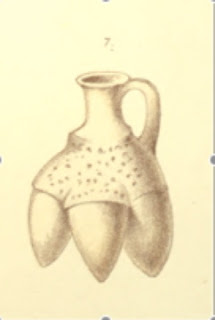While completing my degree in Classics at Leeds University, I am privileged to work as a volunteer with some of Leeds Museums and Galleries' collection of ceramics from the ancient world held in store at Leeds Museum Discovery Centre. These include over a hundred items found in Cyprus, in a wide range of shapes and sizes, which are well represented the Ancient Worlds gallery in Leeds City Museum.
As interesting as the Cypriot ceramics themselves are, so are the routes by which they came to the Museum’s collection. These often reflect the development of the Museum itself, which grew out of the collections of the Leeds Philosophical and Literary Society.
The Society’s collection of antiquities was enriched in 1876 by the purchase of Cypriot artefacts collected by Thomas Backhouse Sandwith. Sandwith was the British Vice-Consul in Cyprus from 1865, and during his time on the island he developed a deep interest in its history and culture. He amassed a considerable collection of artefacts, some of which he brought to England. Unusually for the time, as well as collecting he also studied the ceramics in some depth, and eventually published an article in Archaeologia (the journal of the Society of Antiquaries of London), ‘On the different styles of Pottery found in Ancient Tombs in the Island of Cyprus’ (1877).
Keen to find out more about Sandwith’s collection, I was delighted to discover that this article includes beautifully detailed hand-drawn illustrations of some of his finds by one of the Society of Antiquaries’ skilled draughtsmen. The article is accompanied by only 26 illustrations of ceramics, and unsurprisingly the three artefacts in the Museum known to have been purchased from Sandwith’s collection are not among them. However, I was surprised to recognise the triple vessel illustrated on plate IX, as very similar to one in the Leeds collection I had studied only weeks earlier:
Illustration from Sandwith's article (detail, plate IX)
Juglet from the Leeds Museums and Galleries collection (LEEDM.D.1964.0305)
They are both examples of the intriguing composite ‘juglets’ which take the form of two or three small individual vessels joined together at the neck. The Leeds Museum juglet is made of blackened buff ware, consisting of three cone-shaped vessels joined in a single neck, with a central panel of punched decoration and one handle. This fits closely with the illustration to Sandwith’s article. There is some damage to the rim, which is not visible on the Sandwith illustration, but this could have occurred at any time since the article was written in the 19th century.
There are few additional ‘biographical’ details available about the Leeds Museum vessel. If it is the same juglet illustrated in Sandwith’s article, it may have come into the Leeds Philosophical and Literary Society’s collection as part of the recorded acquisition, or perhaps could have been bought at one of the sales of Sandwith’s collection by someone in Leeds and subsequently donated to the Museum. Whether or not this is what happened, the juglet’s context, both within the range of ancient Cypriot ceramics and in the history of the Leeds Museum, adds to its interest.
Author: Anna Reeve, Volunteer at Leeds Museum Discovery Centre






